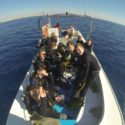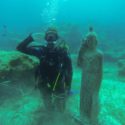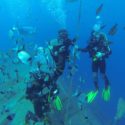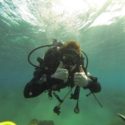Exercise Northern Tartan Diver was a ten day sub-aqua diving expedition to Cyprus from 22nd April 2014 to 1st May 2014. Personnel included eight Officer Cadets and one Group A Officer from the City of Edinburgh University Officer Training Corps, along with one civilian, one regular Cpl and one Captain from outside units. The total expedition strength was twelve. The aim of the expedition was to develop the OCdt’s leadership and confidence and to also gain the British Sub-Aqua Club (BSAC) Ocean Diver qualification.
Prior to deploying to Cyprus, a weekend of pre-deployment training was conducted in the UK. This was done in order to conduct dive theory lessons and practical pool lessons and to also ensure all expedition participants were fit and able to take part in all activities in Cyprus. The lessons conducted in the UK meant that we achieved the Ocean Diver qualification early in Cyprus and we could then do more fun and challenging dives while also working towards the next qualification.
Our first and second days were spent sorting out the large amounts of administration that accompanies scuba diving. The purpose of these dives was to get used to being underwater with all the equipment on again. During these dives we practiced mask removal and clearing; use of alternate air source as donor (“hero”) and recipient (“victim”); development of buoyancy control, finning ability, and use of pilotage.
We began day three at Dhekelia Jetty, focusing on basic diving skills and emergency procedures. Specifically, we practiced ‘mini’ controlled buoyant lifts. In the afternoon we conducted a recreational dive off Green Bay. On this dive there were a number of statues under the water, and the team took the opportunity for some photos. This was the first ten meter dive.
The fourth day included our first dive at Chapel Rock to twenty meters which is our maximum allowed depth as Ocean Divers. Twenty meter dives require a precise ascent rate and safety stop three meters from the surface in order to prevent Decompression Injury.
On day five, we experienced our first boat dive. Boats offer an excellent ability to visit isolated dive sites which other divers would find difficult to access. We made our dives at Fraggle rock to a depth of twenty meters putting our deep dive drills into practice. After five days diving, it’s important practice that a day has to be taken off to let the body recover from all the different pressures it is put through with scuba-diving. Therefore, the sixth day was spent on a cultural visit around the ruins of Achilles house.
Day seven was our first day diving on the Zenobia and can certainly be considered a highlight of the expedition. We explored the maze of rooms inside the wreck and indulged in feeding the copious amounts of marine life that swarmed around us, with sandwiches that we had stuffed somewhat unceremoniously into our buoyancy control jackets.
The last three days consisted of diving the same dive sites but now to a greater depth. Another highlight was achieved on the evening on the ninth day when we conducted a night dive. This was spectacular. Divers are guided by torch and glow sticks. At night there is far more wildlife to see; and you get an opportunity to see wildlife which are nocturnal. We saw eels, cuttlefish, and octopus (all of which were more active than when we had seen them in the day). Swashing fins which disturbed bioluminescent plankton also created quite a show.
The expedition was highly successful and immensely enjoyable. The success of the trip has convinced the Commanding Officer to allow a similar expedition for next year which the OCdt’s are excited about. On behalf of my fellow expedition members, I would like to thank the Ulysses Trust for their support. This expedition couldn’t have been successful without the support from the trust and we look forward to a continued healthy relationship.




